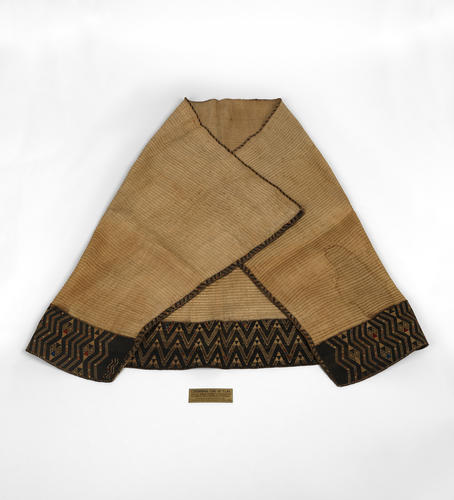-
1 of 253523 objects
Cloak (kaitaka) c.1863
Flax | 182.0 x 110.0 cm (whole object) | RCIN 84606




-
A Māori ceremonial cloak of flax, known as a kaitaka. It is woven from light brown New Zealand flax (Phormium tenax), with a red, black and blue geometric border. Kaitaka were among the most prestigious Māori garments, widely worn in the nineteenth century.
Provenance
Presented to Queen Victoria by Māori Chief Hirini Pakia during his visit to her residence at Osborne House on the Isle of Wight, England, on 15 July 1863.
Queen Victoria recorded the meeting in her Journal for that day, describing '13 Chiefs and the 3 women, 2 of them wives of 2 of the Chiefs. They were half in native, half in European dress. The women wore silk petticoats with their strange cloaks of matting, & feathers in their hair. The men also had cloaks, some skins, thrown over them, carrying spears & hatchets, & feathers stuck in their hair. The greater number of the men were much tattooed, and the women, on their mouths.' The Māori delegation had been brought to England by William Jenkins, a Wesleyan preacher who also served as an interpreter for the colonial government in New Zealand. His aim was to introduce his guests to the wealth and achievements of Britain, while conducting a lecture tour illustrated by indigenous performances. During the tour, the Māori party was received in honour by the Prince and Princess of Wales as well as the Secretary of State for the Colonies. However, disagreement with Jenkins over accommodation and the itinerary, and accusations that he was exploiting his guests, led to the eventual dissolution of their partnership.
This cloak was presented to Queen Victoria with another (RCIN 84605) and later displayed in the Swiss Cottage Museum at Osborne House. It was recorded in the Swiss Cottage Inventory of 1904 as a '"Korowai" - a garment made of wooly [sic] skins'. -
Creator(s)
(nationality)(nationality)Acquirer(s)
-
Medium and techniques
Flax
Measurements
182.0 x 110.0 cm (whole object)
Place of Production
New Zealand